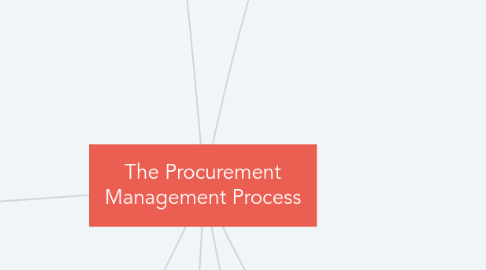
1. Inputs
1.1. Project management plan
1.2. Project procurement documentation
2. Procurement Documents
2.1. Organizational Process Assets
2.2. Bid Invitation
2.3. Request Quotations
3. The Procurement Management Process
3.1. Procurement Management System (s)
3.1.1. It is a systematic approach that is designed to purchase goods and services from the external suppliers. It is a complete process that takes from one month to three months that specifies how supplier and buyer relationships will be managed
3.2. Plan Procurement
3.2.1. Inputs
3.2.1.1. Project schedule
3.2.1.2. Activity cost estimates
3.2.1.3. Stakeholder registers
3.2.1.4. Enterprise environment factors
3.2.1.5. Organizational process assets
3.2.2. Tools and Techniques
3.2.2.1. Market research
3.2.2.2. Expert judgment
3.2.2.3. Make or buy analysis
3.2.3. Outputs
3.2.3.1. Procurement Management Plan
3.2.3.2. Statement of work
3.2.3.3. Procurement documents
3.2.3.4. Make or buy decisions
3.2.3.5. Source selection criteria
3.2.3.6. Request for change
3.2.4. Types Of Contracts
3.2.4.1. Fixed price contracts
3.2.4.1.1. Firm and fixed price
3.2.4.1.2. Fixed price plus incentive
3.2.4.1.3. Fixed price plus economic price adjustment
3.2.4.2. Time and material contracts
3.2.4.3. Cost reimbursable contracts
3.2.4.3.1. Cost with a fixed fee
3.2.4.3.2. Cost with an award
3.2.4.3.3. Cost with an incentive
3.3. The Procurement Cycle
3.3.1. Specific and necessary products
3.3.2. Source of products
3.3.3. Price, terms and conditions
3.3.4. Recognition of the requirements
3.3.5. Purchase order specifications
3.3.6. Mode of delivery
3.3.7. Order expedition
3.3.8. Acceptance and inspection of orders
3.3.9. The approval of invoices
3.3.10. Maintenance of records
4. Conduct Procurements
4.1. Inputs
4.1.1. Project management plan
4.1.2. Find selection criteria
4.1.3. Sellers list
4.1.4. Project documents
4.1.5. Make or buy decision
4.1.6. Organizational process assets
4.2. Tools and Techniques
4.2.1. Conference of bidders
4.2.2. Evaluation of proposals
4.2.3. Estimates
4.2.4. Expert judgment
4.2.5. Advertising and search
4.2.6. Negotiations
4.3. Outputs
4.3.1. Selected sellers
4.3.2. Procurement contract award
4.3.2.1. It is the method that is used during the procurement for evaluating the participating proposals and then awarding the relevant contract.
4.3.3. Resource calendars
4.3.4. Updates in plan
4.3.5. Project document updates
5. Close Procurements
5.1. Tools and Technologies
5.1.1. Procurement audits
5.1.1.1. It is a process that depicts that how the resources should be managed until the contract is closed. The audit reviews the different processes and determines the accuracy and efficacy of the procurement process.
5.1.2. Settlements
5.1.3. Record management systems
5.2. Outputs
5.2.1. Closed Procurements
5.2.1.1. Unsolved claims
5.2.1.2. Early closure of contracts
5.2.2. Organizational Process Updates
6. Control Procurements
6.1. Inputs
6.1.1. Procurement documents
6.1.2. Contract
6.1.3. Project management plan
6.1.4. Work performance reports
6.1.5. Performance data
6.2. Tools and Techniques
6.2.1. Contact change control system
6.2.2. Procurement plan review
6.2.3. Audit
6.2.4. Performance reporting
6.2.5. Payment system
6.2.6. Claim administration
6.2.7. Records management
6.3. Outputs
6.3.1. Work performance information
6.3.2. Change requests
6.3.3. Project documents update
6.3.4. Organizational process updates
